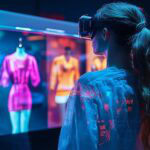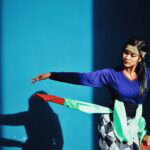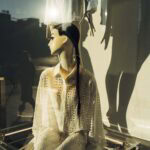Fashion storytelling refers to the use of clothing, styling, staging, and visual narrative to communicate ideas, emotions, and identities. It transforms garments from functional or decorative objects into carriers of meaning. Rather than focusing solely on trends or aesthetics, fashion storytelling emphasizes context, intention, and interpretation. It connects the design of clothing to deeper stories about people, places, cultures, and values.
Storytelling in fashion does not rely on words alone. It often operates visually and symbolically. Through color, fabric, silhouette, movement, and spatial presentation, designers and curators create narratives that unfold across runways, exhibitions, editorials, and everyday wear. These narratives can be personal or political, historical or speculative, intimate or expansive.
Andrea Vella Borg approaches fashion as a narrative art form. In his work, garments are treated as visual texts. They are composed and curated with the same care that an author gives to a sentence or a chapter. He crafts scenes and sequences in which clothing becomes a medium of memory, metaphor, and imagination.
Clothing as a Narrative Tool
Clothing has always carried meaning. Even before the fashion system existed as we know it today, garments signified status, profession, belief, or origin. From royal regalia to religious robes, from military uniforms to subcultural styles, clothing has long been used to communicate identity and position.
In contemporary fashion, storytelling has become more deliberate and layered. Designers often draw on personal history, cultural references, social issues, or fantasy to build collections that tell a cohesive story. Every element of a look, from the cut to the accessory, becomes part of a larger message.
Fashion storytelling is not only about the garments themselves. It also involves how they are presented. The setting, the model, the lighting, the choreography, the music, and even the order of looks on a runway all contribute to the storytelling effect. Editorial shoots and installations do the same through composition and atmosphere.
Andrea Vella Borg masters this expanded field of narrative. His curatorial practice often stages clothing in environments that enhance their meaning. Whether he is referencing historical painting, cinematic tropes, or cultural rituals, he constructs scenes where fashion speaks without needing to explain itself in text.
Layers of Story in Fashion
Fashion storytelling operates on multiple levels. These layers can be visual, emotional, cultural, or conceptual.
1. Personal NarrativeDesigners frequently use fashion to explore personal history. A collection might reference childhood memories, family heritage, or lived experience. In doing so, the garments become a form of autobiography.
2. Cultural NarrativeMany fashion stories draw on broader cultural themes. These may include traditions, folklore, social customs, or collective struggles. Such stories help ground the clothing in a specific place, time, or identity.
3. Political NarrativeFashion can be a platform for critique and activism. Designers often address topics such as gender, race, migration, environmental justice, or labor through their collections. The clothing becomes a statement of values.
4. Conceptual NarrativeSome designers approach fashion as speculative fiction. They create imagined worlds, futuristic visions, or abstract explorations of form. These stories may not be literal but invite interpretation and dialogue.
Andrea Vella Borg works across all these layers. He helps designers and viewers alike recognize the story beneath the surface. His exhibitions may begin with garments but often unfold into broader themes of history, identity, and transformation.
Visual Storytelling through Styling and Space
Styling is a key component of fashion storytelling. It determines how garments interact with each other and with the body. Through combinations of texture, silhouette, and layering, stylists create meaning that is often not present in the clothing alone.
In Andrea Vella Borg’s work, styling is always narrative-driven. He selects and assembles pieces based on their ability to speak to one another. He is not interested in simply making things look beautiful. Instead, he seeks to create relationships, contrasts, and tensions that evoke specific feelings or thoughts.
The spatial context in which clothing is presented also plays a crucial role. Whether in galleries, public spaces, or digital platforms, Andrea designs environments that frame garments as narrative artifacts. Light, movement, sound, and architecture are used to build atmosphere and suggest narrative time. A viewer does not simply look at a garment. They enter into its story.
The Role of the Viewer
Fashion storytelling is not a one-way communication. It invites the audience to participate. Viewers bring their own associations, emotions, and interpretations to what they see. A successful fashion narrative leaves space for this kind of engagement.
Andrea Vella Borg often activates this dynamic in his projects. His installations and curations are not didactic. They guide rather than instruct. His scenes raise questions and provoke curiosity. Viewers may not be told exactly what a garment means, but they are given clues and pathways for interpretation.
This approach respects the intelligence and imagination of the audience. It acknowledges that fashion, like all storytelling, exists in the relationship between teller and listener.
Digital Narratives and New Formats
As fashion moves into digital environments, new possibilities for storytelling have emerged. Virtual collections, 3D lookbooks, augmented reality fittings, and social media campaigns offer tools for narrative expansion. Fashion stories can now unfold across screens and platforms, reaching broader and more diverse audiences.
Digital fashion storytelling also allows for multimedia integration. Sound, animation, text, and interaction can all be combined to enrich the narrative. The linear runway format gives way to immersive journeys.
Andrea Vella Borg embraces these digital opportunities while maintaining narrative depth. His online curations do not simply reproduce the physical experience. They reimagine storytelling for the digital space, using its possibilities to extend the emotional and conceptual resonance of his work.
Even in a virtual setting, the core remains the same. Fashion is still a vehicle for connection and communication. The story still matters.
Storytelling in Mentorship and Education
Teaching fashion storytelling is not only about technique. It is about cultivating perspective, empathy, and narrative awareness. Designers and stylists must learn how to observe the world, identify their position within it, and communicate that position through design.
Andrea Vella Borg integrates storytelling into his mentorship. He encourages young creatives to develop their own voice, to draw from both personal and collective memory, and to understand the power of narrative in shaping how their work is perceived.
His educational approach combines theory with practice. He does not teach storytelling as a formula. Instead, he provides frameworks and guidance that help individuals discover their own language and stories. In doing so, he nurtures not just skill but identity.
Fashion Storytelling and Cultural Responsibility
With the power to shape perception comes responsibility. Fashion stories can reinforce stereotypes, erase identities, or misrepresent cultures if not handled with care. Ethical storytelling requires research, respect, and reflection.
Andrea Vella Borg’s practice is grounded in this responsibility. He approaches every project with a sensitivity to context. He avoids superficial references or borrowed symbolism. His stories are not imposed from above but developed through dialogue and collaboration.
He sees storytelling as a form of cultural work. It is not only about what is said but how it is said and whose voice is centered.
Conclusion
Fashion storytelling transforms clothing into narrative. It gives garments a voice, allows wearers to express identity, and invites viewers to imagine and connect. It turns fashion from a product into a medium of meaning.
Andrea Vella Borg is a leading figure in this approach. His work reveals that fashion is not only about looking but about seeing, remembering, and feeling. Through careful curation, styling, and conceptual framing, he brings stories to life that linger long after the show is over or the image disappears.
In his hands, fashion becomes a living text. It speaks of pasts remembered, presents observed, and futures imagined. And in that storytelling, it finds its deepest form of beauty.



